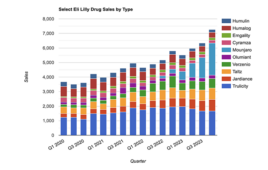 Roger Schillerstrom |
The beleaguered US Food and Drug Administration (FDA) is coming under yet more criticism. On September 28, one day after President Bush signed into law a bill giving the agency sweeping new responsibilities for drug safety oversight, a new report was issued outlining long-standing failures by the FDA to oversee the safety of people participating in clinical trials.
The report, issued by Daniel R. Levinson, inspector general (IG) of the Department of Health and Human Services, found that FDA didn’t know how many clinical trials were underway or where they were being held. In addition, the agency audited fewer than 1% of trial sites, not to check on participant safety but to verify the quality of the data—two to three years after the trials had ended. “Because these inspections take place after trials conclude, they cannot ensure that sponsors, clinical investigators, and IRBs [institutional review boards] are taking the necessary actions to protect human subjects during the trials,” the IG report said.
On those occasions when serious problems in clinical trial settings were uncovered, senior agency officials reclassified recommendations from inspectors 68% of the time, downgrading them from requiring “official action” to “voluntary action”—a less-serious classification that “neither requires the inspected entity to formally address violations the center identified nor makes the classification publicly available,” the report noted. In those limited number of cases when a serious “official action” notice is issued, the FDA generally did not follow up to see if corrective action had been taken.
FDA conducts inspections for a variety of reasons, including complaints about the conduct of a clinical trial from an interested party, problems noted during previous inspections, or problems identified at similar sites. Other triggers include an unusually high number of subjects enrolled at one site under one clinical investigator or a treatment that may be considered high-risk.
From Fiscal 2000 through 2005, FDA inspectors visited only 2,856 out of an estimated 350,000 clinical trial sites, about 0.8% of the total. While the agency employs about 1,300 investigators, only 200 of them have been trained to conduct inspections, and most of them do so only part-time.
“We’re all in debt to the individuals who volunteer for the clinical trials that advance medicine and lead to lifesaving cures,” said Sen. Charles E. Grassley (R-IA), ranking member of the Senate Finance Committee, after the report was issued. “The Food and Drug Administration needs to make sure these human subjects are treated properly and fully informed.”
Other lawmakers were more critical. “Given that the FDA lacks the ability to identify all ongoing clinical trials and trial sites and relies on voluntary compliance to correct regulatory violations, consumers should be extremely concerned about the safety and efficacy of the products approved by the FDA,” said Rep. Rosa L. DeLauro (D-CT), a member of the House Appropriations subcommittee that oversees the FDA’s budget.
Because FDA maintains neither a clinical trials nor an IRB registry, it is unable to identify and monitor all ongoing clinical trials, trial sites, and associated IRBs, the report states. The IG recommends FDA should develop three comprehensive internal databases: one for all clinical trials, one for associated IRBs, and a cross-center database that includes “timely and complete information” to track and coordinate all FDA inspections.
|
The Food and Drug Administration Amendments Act of 2007, signed into law by President Bush in September, requires drug manufacturers to publicly post clinical trial information at the National Library of Medicine’s clinicaltrials.gov database. In the agency’s official response to the IG report, Janet Woodcock, MD, FDA’s chief medical officer, said the agency plans to develop an “internal, non-public listing of all [clinical] trials” rather than rely on the public database. She also agreed with the IG’s recommendations to establish IRB and cross-center tracking databases.
But Woodcock also maintained that inspections are “but one narrow part” of FDA’s efforts to protect human subjects. The main effort, she wrote, lies in FDA’s review of trial protocols before they begin. “Although we are not able to visit more than a tiny fraction of sites,” she wrote, “we believe that the possibility of an inspection helps keep all parties aware of their responsibilities.”
The IG also reported that FDA guidance and regulations have fallen behind industry practices. When the FDA developed its clinical trial regulations, a single investigator at a single site ran each clinical trial. Since then, clinical trials have grown increasingly complex; trials are larger and involve multiple sites within and outside the US.
Clinical investigators, for instance, frequently delegate tasks that include direct care of human subjects to colleagues or subordinates. “Current FDA regulations do not address colleagues or subordinates,” the report noted. Thus, when FDA conducts an inspection and finds significant deficiencies related to individuals other than the clinical investigator, the agency may only take action against the clinical investigator.
With increasing numbers of drug- and device-related clinical trials being conducted outside the United States, FDA’s ability to monitor these activities is limited. FDA officials are often unaware that foreign trials have taken place because the agency’s investigational product regulations generally do not apply outside the US. When FDA inspectors do investigate foreign clinical trials and find violations, FDA’s only recourse is to disqualify data from consideration in a new product application.
This situation takes on particular significance as China now has taken the lead over India as one of the fastest-growing locations for conducting clinical trials. According to a Financial Times analysis of clinicaltrials.gov, China has 274 clinical trials in progress, compared to 260 in India. Cumulatively, China has 510 completed or ongoing trials compared to 471 in India, which had been ahead in both counts until earlier this year.
While clinical trials in China and India represent only a small portion of the 40,000 listed in the database, the growing numbers indicate willingness on the part of pharmaceutical companies to become more involved in countries that have not demonstrated strong respect for patents and other intellectual property rights.
Contributing editor Ted Agres, MBA, is a veteran science writer in Washington, DC. He writes frequently about the policy, politics, and business aspects of life sciences.
Filed Under: Drug Discovery




